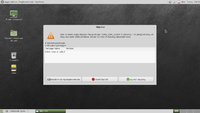Your question concerns the user's ability to grasp what exactly it is that the repository delivers, down to the level of an individual entry. Because both concepts, Package and App, do exist and will not go away, I would first try to make the distinction between these two understandable in an intuitive way.
To a new user, the difficult thing is that very distinction (or, even knowing that it exists in the first place). Once it is understood, there may not be a significant problem (though I'm making a guess here based in the assumption that multi-App Packages will not be the norm anyway).
As for how exactly the distinction can be conveyed in intuitive ways without necessitating a manual for the repository, one idea could be to list Packages, but if a Package has multiple Apps, list each App instead, and display the name of each as something like "Game Name - Software 1/2 in examplepackage.dbp", "Game Name Level Editor - Software 2/2 in examplepackage.dbp".
I'm tending towards stating that every Package should have its own page (which lists and shows information about all Apps of the Package, if there are several), but individual Apps should not. It may be difficult to convey the latter concept, and at the current time, personally I do not expect packages with many Apps inside to become a very regular sight. I may be wrong, of course.
Not to mention, one page per Package is Neat™, and that is not to be underestimated...


